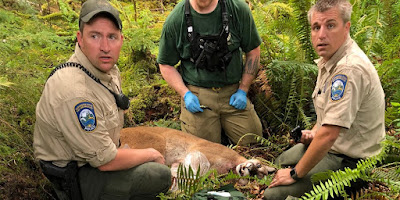A lifeline in an arid landscape - the Okavango Delta, Botswana
The Okavango Delta! For 50,000 years, animals and people have depended on this inland delta. None of the water reaching the Delta from its tributaries reaches any ocean or sea. It all evaporates, is consumed through transpiration by plants, or goes underground into the aquifer. Flooding peaks between June and August, and we visited in June. The water was JUST beginning to rise. This water is a magnet for wildlife.
 |
| Satellite image of the Okavango Delta, with national borders added. |
Ironically, on the KLM flight from San Francisco to Amsterdam to Johannesburg, we were offered a number of movie selections, and one was Into the Okavango, a movie where explorers went on a four-month, 2400 kilometer (1500 mile) expedition across three countries to understand the Delta from its source to its termination. On the return trip, when I watched the movie again, I recognized most of the bird species!
 |
| African jacana. This bird is a common resident around water in the Okavango Delta. With those long toes, it appears to walk on water as it crosses aquatic vegetation, giving it the nickname, the "Jesus bird." |
We flew to a grass airstrip on a small plane, were met by staff from the Saguni Lodge, and actually settled in during the daytime (a new experience).
 |
| The view from our tent. |
 |
| It was always fun to eat without wearing all of our coats! |
 |
| Nile crocodile basking. |
 |
| Giraffes at sunset. |
 |
| The Okavango Delta is FLAT, with a variation of only 2 meters over its vast reach. Termite mounds are essential 3D structures used by plants and animals. |
 |
| "I see you, too." |
 |
| Back on the water! |
 |
| Hippo road block. |
 |
| Malachite kingfisher. |
 |
| Better photo from Wikipedia. |
 |
| Back on terra firma. |
 |
| Grey heron standing on the back of hippos. |
 |
| Back at camp! We all got a hot towel to wipe the dust off our faces. |
As this was our last camp, I needed to revisit my wish list of things I wanted to experience during this trip:
• Finally figure out where the Southern Cross is and how it is used for navigation. Done in Hwange and Kafue, and used as we were driving at night in the Okavango Delta.
• Hug a baobab tree. Did this in Kafue!
• Watch a dung beetle do its thing. Not yet.
• Hear and feel an elephant rumble. Well, I heard the rumble in Hwange, but I didn't feel it. I probably needed to be closer, and standing on the ground.
It was my birthday! And I wanted to see that darn dung beetle! But, alas, I was told multiple times that you tend to see them during the wet season. I don't know if I believe this... "dung happens" all year round, and there is plenty of dung near ponds and rivers. But the next few photos tell you how hard I was trying to see one!
 |
| Elephant track. |
 |
| No dung beetles here. |
 |
| Maybe if I root around a bit... could a dung beetle be playing hide and seek? |
 |
| What others do when you are looking for dung beetles. |
 |
| Can you guess what made this mark? An elephant trunk. |
 |
| Lisa got really good at climbing in and out of the Land Rovers! Impressive for a gal in her 80s! |
 |
| Main camp area. |
 |
| Final view from camp. |
 |
| Back on the plane! This time, with no external battery! It heated up and had to be removed from the plane on the way here. |
•••••
There is so much I can discuss and show at all the national parks... Hwange, Kafue, Chobe, and the Okavango Delta, that I'm limited by my own attention span.
But I did get a "behind the scenes" tour of the Saguni Lodge, thanks to Manager Jinxy! There are 20-ish staff... cooks, mechanics, guides, housekeepers, laundry workers, and supervisors. It takes a lot of work to keep nine visitors safe, well-fed, and comfortable!
 |
| Jinxy was very knowledgable about how his camp worked. |
 |
| Staff housing. Upgrades are in the works. Obviously, these huts get hot, and staff lounge and eat outside... where the animals are. |
 |
| Triple filtered, reverse osmosis water filtration. |
 |
| What's for dinner? The whole kitchen set-up was clean and modern. |
 |
| The cook's private stash of spices. |
 |
| Jinxy discussing solid waste management. The use permit for the site requires that human impacts be minimal. |
 |
| Food storage inside a sealed container. Fresh fruits and vegetables are flown in weekly. Staple goods are trucked in. |
 |
| Batteries for solar panels. The existing panels produce excess power, but more batteries are needed to store it. |
 |
| Here, linens are soaking before they are scrubbed by hand. |
 |
| Jinxy was very proud of the black water (sewage) system. The raw material circulates through a series of tanks as it is treated. |
 |
| Water towers in background. Caroline and Paresh. |
 |
| Each and every guest is tracked on the daily task board. |
 |
| Can you guess where we are headed next? |



























Comments
Post a Comment